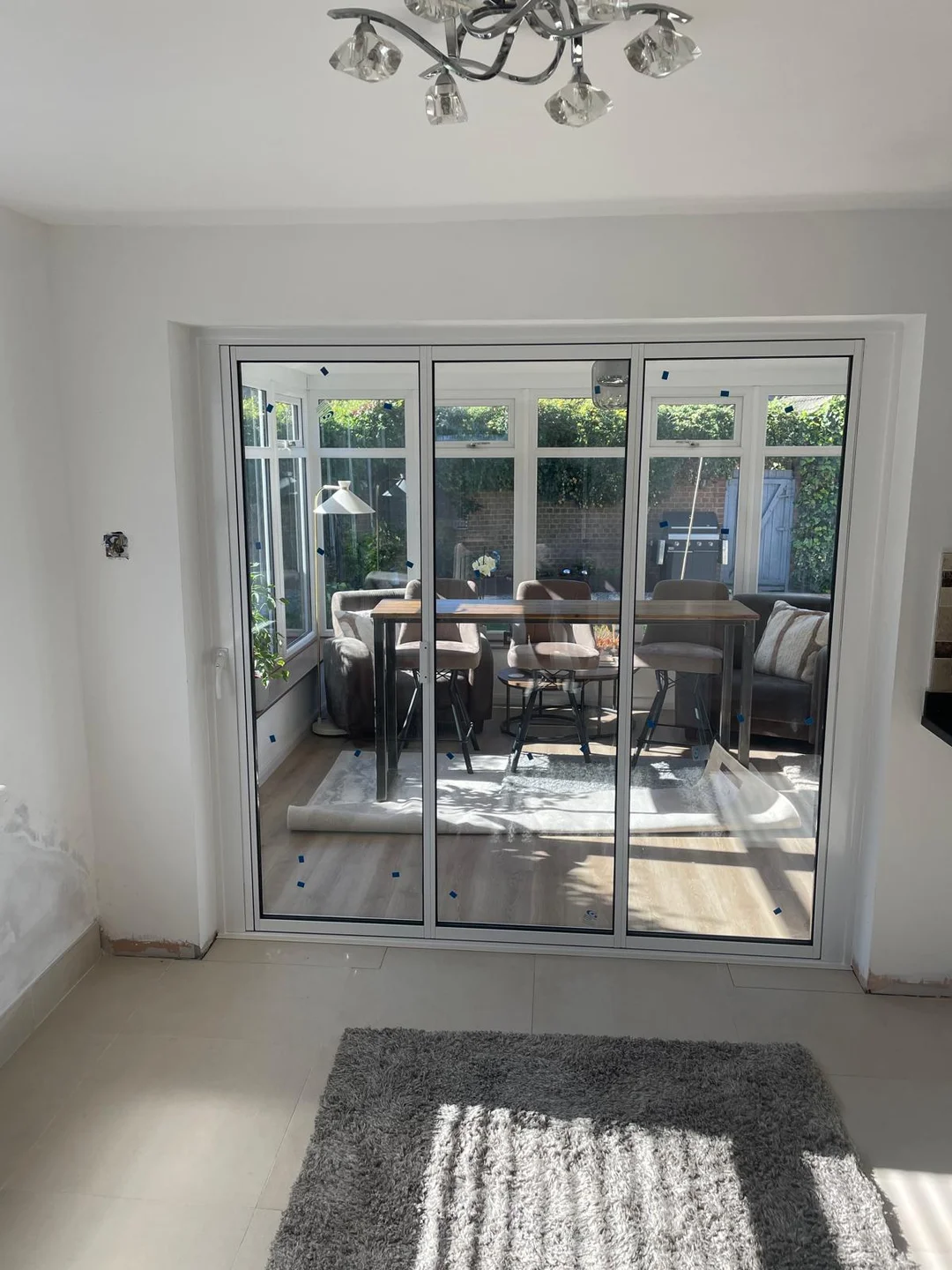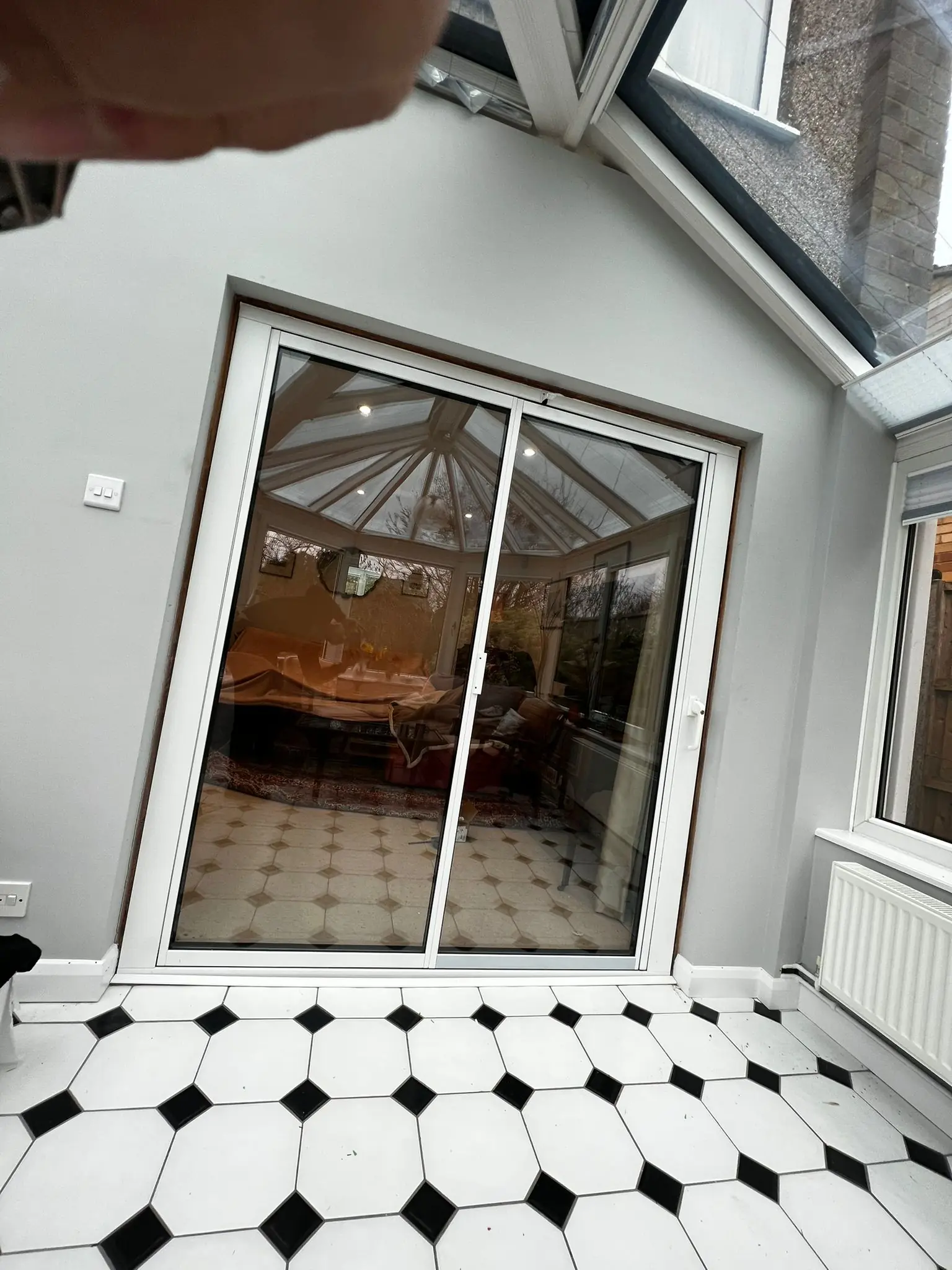White Internal Bifold Doors Styling Guide
Table of Contents

Types of White Internal Bifold Doors
White internal bifold doors come in many styles, from ultra-modern flat panels to classic raised designs. Their rising popularity stems from their mix of practicality and style, making them a smart choice for any room needing flexible space division.
Matte vs Gloss White Finishes
Matte white finishes absorb light rather than reflecting it, creating a soft, warm appearance that fits naturally into most living spaces. Light bounces differently off matte surfaces, reducing visible fingerprints and making scratches less noticeable over time.
Gloss finishes on white internal bifold doors reflect more light around the room, brightening darker spaces and creating a modern, polished look. The reflective surface works particularly well in contemporary homes where clean lines take centre stage. You’ll need to wipe gloss doors more often to maintain their shine, though the smooth surface makes cleaning quick and simple.

Painted vs Laminated Surfaces
Painted white internal bifold doors offer a traditional feel with their slightly textured surface. Professional spray-painting produces smoother results than brush application, while still allowing the natural characteristics of the door material to show through. The paint layer can be refreshed years later if you fancy updating the shade of white or switching to a completely different colour.
Laminated surfaces bring extra durability to white internal folding doors, with a hard-wearing outer layer that resists chips and scratches. The consistent finish maintains its appearance without needing touch-ups, making these doors particularly suitable for busy households with children or pets.
Woodgrain or Smooth Textures
Woodgrain textures add subtle depth to white internal bi fold doors, mimicking the natural patterns found in timber. The gentle texture catches light differently throughout the day, creating visual interest without dominating the space.
Smooth finishes suit modern interiors where simplicity reigns supreme. The clean lines of a flat surface complement geometric furniture and minimal décor choices, while still providing enough visual weight to anchor the space. Both options work equally well – your choice should match the overall style of your room rather than following rigid rules about what looks best.
Choosing Hardware for White Internal Bifold Doors
The right hardware choices make all the difference to how white internal bifold doors look and operate in your home. Quality fittings add polish to the overall appearance while improving day-to-day usability.
Handle Styles and Finishes
Brushed nickel handles strike a balance between durability and style on white internal bifold doors, resisting fingerprints while providing a subtle metallic accent. Chrome offers a brighter alternative, though its mirror finish requires more frequent cleaning to maintain its sparkle. Matte black hardware creates striking contrast against white surfaces – particularly impactful in modern interiors where bold design statements take priority.
Flush handles sit completely flat when not in use, preserving clean lines across the door panels. Their minimal profile suits slim profile bifold doors especially well, maintaining the streamlined appearance that makes these designs so popular. Pull handles mounted vertically give extra leverage when moving larger door configurations, while horizontal options work better on smaller setups where space might be tight.

Track and Runner Options
Top-hung systems support white internal folding doors from above, allowing for smoother operation compared to bottom-rolling alternatives. The weight distribution through the top track helps prevent doors from sticking or requiring extra force to move, even after years of regular use. Premium runners use small wheels wrapped in nylon, virtually eliminating the squeaks and rattles that often develop in lesser quality systems.
White aluminium bifold doors typically come with matching track systems, though contrasting finishes can create interesting design features. Hidden runners tucked away in the frame keep the focus on the doors themselves rather than the mechanical elements that make them work. Floor channels can be recessed into the flooring during installation, creating an almost invisible boundary between rooms.
The number of door panels determines how many handles and hinges you’ll need, with larger configurations requiring intermediate handles for easier operation. Standard three-panel setups usually work best with handles on the lead and end panels, while five-panel arrangements might benefit from an extra pull point in the middle.
Track and Runner Features
Internal bi-fold doors need properly specified tracking systems to operate reliably over time. Spring-loaded runners compensate for slight shifts in the building structure, preventing doors from binding or becoming difficult to operate as seasons change. Precision-engineered bearings in high-quality runners reduce friction points, resulting in doors that glide open with minimal effort.
Anti-jump mechanisms built into the track system keep panels securely in place, preventing them from coming off the runners during operation. Adjustable hinges let you fine-tune the alignment between panels, ensuring uniform gaps and smooth folding action. Some systems incorporate soft-close devices that gently pull the doors into their fully open or closed positions, stopping panels from swinging or banging.
Handle Materials and Durability
Solid brass handles, while pricier than zinc alloy alternatives, offer exceptional longevity and develop an attractive patina over time. Stainless steel options resist corrosion without requiring special care, making them practical choices for busy households. Powder-coated finishes applied to metal handles create durable surfaces that won’t chip or flake with normal use.
Door pulls should feel substantial in your hand – lightweight handles often indicate lower quality materials that might not stand up to daily use. The mounting method matters too: through-bolted handles provide more stability than those attached with simple screws, especially on doors that see frequent operation.
White Internal Bifold Doors in Different Room Styles
White internal bifold doors possess remarkable adaptability, fitting easily into various interior design schemes while maintaining their practical benefits. The key lies in matching them thoughtfully with your existing style elements.
Modern Minimalist Spaces
Clean lines and simple forms define minimalist interiors, where white internal bifoth doors shine particularly well. Light bounces off their surfaces, creating an airy atmosphere that complements sparse furnishings and uncluttered spaces. A folding mechanism with hidden runners keeps the technical aspects out of sight, preserving the pared-back aesthetic that characterises minimalist design.
Monochromatic colour schemes gain depth through subtle variations in white tones. Pairing pure white walls with slightly warmer white internal bifold doors creates subtle layering without disrupting the minimal aesthetic. Metal accents in brushed steel or chrome add definition while staying true to minimalist principles.
Period and Vintage Properties
Victorian and Edwardian homes often feature ornate architectural details that might seem at odds with modern door systems. However, white internal folding doors can work beautifully in period properties when styled appropriately. Raised panel designs echo traditional door patterns, while simple beading adds character without appearing overly modern.
Original features like ceiling roses and cornicing find natural companions in white bifold doors with classical proportions. The doors’ clean appearance provides a neutral backdrop that allows period details to remain the focal point. Brass hardware in traditional styles helps bridge the gap between old and new elements.
Coastal and Beach House Themes
Seaside-inspired interiors benefit from the fresh, bright quality of white internal bifold doors. Sandy beiges and ocean blues pair naturally with white, creating a relaxed atmosphere reminiscent of coastal living. Textured glass panels within the doors can mimic the frosted appearance of sea glass, adding another layer of maritime charm.
Natural materials like rope, driftwood, and woven textures contrast beautifully with smooth door surfaces. Light filtering through partially opened doors creates patterns similar to sunlight playing on water, especially when paired with sheer curtains that move in the breeze.
Small Spaces
Compact homes demand smart use of every square metre, making the space-saving nature of bifold doors particularly valuable. When fully opened, these doors tuck neatly against the wall, freeing up precious floor space that swing doors would occupy. White finishes help small rooms feel more open by reflecting available light.
Space Planning Techniques
Strategic placement of white internal bifold doors can define distinct zones within limited square footage. Home offices separate naturally from living areas without sacrificing the open feel that makes small spaces work. The doors’ ability to fold completely back allows rooms to flow together when desired, while providing privacy when needed.
Glass panels within the door design permit natural light to penetrate deeper into interior spaces, making narrow hallways and darker corners feel brighter and more inviting. Mirrored panels serve double duty by increasing the perception of space while maintaining privacy when closed.
Pattern and Texture
Panelled white doors introduce subtle geometric interest that works with various design styles. Herringbone flooring or patterned tiles near the doorway create striking ground-level interest without competing with the doors themselves. Wall coverings in gentle patterns provide background interest while allowing the doors to remain a strong architectural element.
Woven materials and natural fibres bring organic texture to spaces divided by white internal doors. Sisal rugs, linen curtains, and grasscloth wallcoverings add depth through their tactile qualities. These elements soften the crisp lines of modern door designs while maintaining a cohesive overall appearance.
Creating Contrast with White Internal Bifold Doors
Strong visual contrasts bring rooms to life, and white internal bifold doors provide an ideal foundation for bold design choices. Smart combinations of colours, materials, and textures create striking yet balanced interiors that catch the eye.
Bold Wall Colours
Deep navy walls make white internal bifold doors pop while maintaining a sophisticated atmosphere. Rich emerald greens create a nature-inspired backdrop that feels both timeless and on-trend. Rather than playing it safe with neutral shades, experimenting with saturated colours allows white internal folding doors to become a striking architectural feature.
Colour blocking techniques work particularly well with white doors as the central dividing element. A burnt orange feature wall on one side of white internal bifold doors paired with sage green on the other creates distinct zones while maintaining visual harmony. Paint colours that wrap around corners or extend partially onto ceilings draw attention to architectural features without overwhelming the space.

Dark Flooring Combinations
Walnut and ebony wooden floors provide strong contrast against white internal bifold doors, creating a grounding effect that anchors the room. Small bifold doors appear more substantial when framed by dark timber flooring, while the white finish prevents the overall scheme from feeling heavy.
Black slate or polished concrete floors offer contemporary alternatives to wooden finishes. The industrial edge of these materials balances beautifully with the crisp lines of modern door designs. Patterned tile flooring near the doorway draws attention to the threshold while adding personality to the space.
Surface Finishes and Light
Matt flooring surfaces reduce glare and create subtle contrast with gloss-finished doors. Alternatively, polished floors mirror light around the room, amplifying the brightness that white doors naturally bring to a space. The interplay between different surface finishes adds depth without relying solely on colour for contrast.
Natural Materials and Textures
Raw timber beams overhead create striking vertical contrast with horizontal door panels. Exposed brick walls in warm terracotta tones bring rustic character while allowing glass doors to maintain their contemporary appeal. Stone feature walls add textural interest that complements rather than competes with white door finishes.
Woven pendant lights cast interesting shadows across door surfaces throughout the day. Chunky knit throws and textured cushions soften the clean lines of modern door designs. Natural materials like rattan, jute, and bamboo introduce organic elements that prevent white-dominated spaces from feeling clinical.
Patterned Textiles and Accessories
Bold geometric rugs placed near white internal bifold doors create zones within open-plan spaces. Abstract artwork mounted adjacent to door frames draws the eye upward, making rooms feel taller. Textiles featuring strong patterns work well when separated by white doors, preventing busy designs from overwhelming the space.
Metallic accessories reflect light in interesting ways, adding sparkle without competing with the doors’ clean aesthetic. Copper plant pots, brass picture frames, and chrome lighting fixtures introduce shimmer at different heights throughout the room. These metallic elements catch the eye as doors open and close, creating dynamic visual interest.
Wall hangings in rich textures – from woven tapestries to macramé pieces – break up large white surfaces without permanent commitment. Layering different patterns through curtains, cushions, and rugs creates depth while maintaining balance. The doors’ white finish acts as a visual pause between competing patterns, preventing the space from becoming chaotic.
Playing with Scale
Large-scale wallpaper designs on feature walls make bold statements without overwhelming the space when broken up by white door panels. Oversized art pieces hung near door frames create focal points that draw attention to the architecture. Small, intricate patterns in textiles and accessories provide counterpoints to the doors’ simple lines.
Light fixtures scaled to match door heights create visual harmony. Pendant lights hung at different heights add vertical interest while highlighting the doors’ clean lines. The careful balance of large and small elements prevents any single feature from dominating the space.
Room-Specific Design Tips for White Internal Bifold Doors
Different rooms in your home present unique opportunities for using white internal bifold doors creatively. Each space requires specific approaches to layout, lighting, and styling to make the most of these flexible room dividers.
Kitchen and Living Space Dividers
White glass kitchen doors bring flexibility to open-plan areas without sacrificing the benefits of connected spaces. In kitchen-living spaces, the doors allow cooking odours to be contained when needed while maintaining visual connection through glazed panels. Morning sunlight streams through when the doors stand open, yet privacy remains possible during dinner parties or when the washing up waits.
Positioning furniture away from the door swing arc creates natural pathways between zones. Low-level storage units or console tables along walls provide useful surfaces without blocking light flow. Plants placed near white internal folding doors thrive in the abundant light while softening architectural lines.
Sound Management
Strategic placement of soft furnishings helps manage noise between separated areas. Rugs, curtains, and upholstered seating absorb sound without compromising the clean aesthetic of white internal bifold doors. Cork or rubber underlays beneath hard flooring reduce impact noise when doors are closed.
Bedroom and Dressing Areas
White internal bifold doors shine in master suites, creating luxurious dressing areas that feel connected yet separate from sleeping spaces. Full-height mirrors mounted on door panels double as practical dressing aids while bouncing light around the room. The doors’ flat surfaces provide ideal backdrops for pendant lights or wall sconces that illuminate dressing areas effectively.
Internal bi-fold doors between bedrooms and en-suites offer privacy without eating into valuable floor space. Steam-resistant paint finishes maintain their appearance despite bathroom humidity, while sealed bottom rails protect against water splashes. Magnetic catches hold doors securely closed, preventing unwanted movement during night-time bathroom visits.
Home Office Spaces
Remote working demands quiet focus areas within busy households. White internal bifold doors create dedicated home offices that close off completely during video calls yet open wide when family time takes priority. Desk positioning perpendicular to the doors reduces screen glare while maintaining easy access to the rest of the house.
Sound-dampening strips along door edges limit noise transfer, letting you take calls without disturbing others. Cable management built into door frames keep power and data lines tidy when running between rooms. Adjustable ventilation panels within door designs help maintain comfortable working temperatures without compromising privacy.
Multi-Purpose Rooms
Spare rooms become more useful with white internal bifold doors dividing the space. A home gym shares space with a guest bedroom, separated when needed yet fully open for larger exercise sessions. Craft areas tuck away behind closed doors, keeping works-in-progress hidden until ready for display.
Wall-mounted desks fold down when doors are open, creating temporary workstations without permanent space commitment. Storage solutions integrated into adjacent walls keep supplies organised and easily accessible. The doors’ clean lines maintain visual calm despite changing room functions.
Window Treatments
Layered window treatments work particularly well alongside bifold door arrangements. Sheer curtains filter sunlight while maintaining privacy, with blockout layers adding complete light control when needed. Curtain tracks recessed into ceiling bulkheads create clean lines that complement modern door designs.
Roman blinds mounted within door frames move with the panels while providing additional privacy options. Their neat stack height when raised preserves door functionality without compromising headroom. Coordinating blind fabrics with other soft furnishings pulls the room scheme together while maintaining practical benefits.
Floor-length curtains hung wider than door openings create the illusion of larger windows when drawn. Light-coloured fabrics complement white door finishes while adding softness to hard architectural lines. Motorised options sync with smart home systems, adjusting automatically with door operations.
We’d Love to Help You
Vision Glass Doors is a designer, manufacturer, and installer of premium door systems. We are a family run business with over 20 years’ experience and 5,000 installations across the UK.
Our leading range of door systems include Ultra Slim – Slide and Turn Doors, Slimline Sliding Patio Doors and Frameless Glass Doors. Suitable for various internal and external applications, they are applicable to residential and commercial projects.
Click Quick Quote Online for a free quotation within 24 hours. Alternatively, call or email us on 01582 492730 or at info@visionglassdoors.co.uk.

